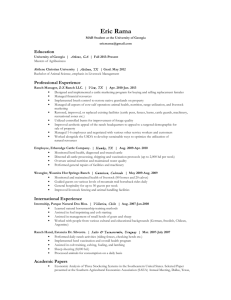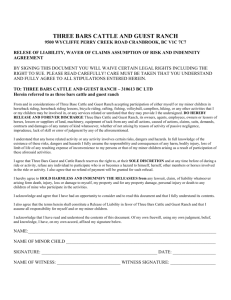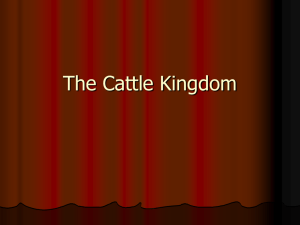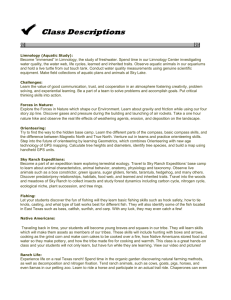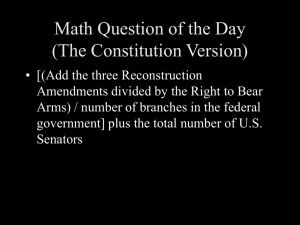Chapter 18 “The Cattle Kingdom”
advertisement
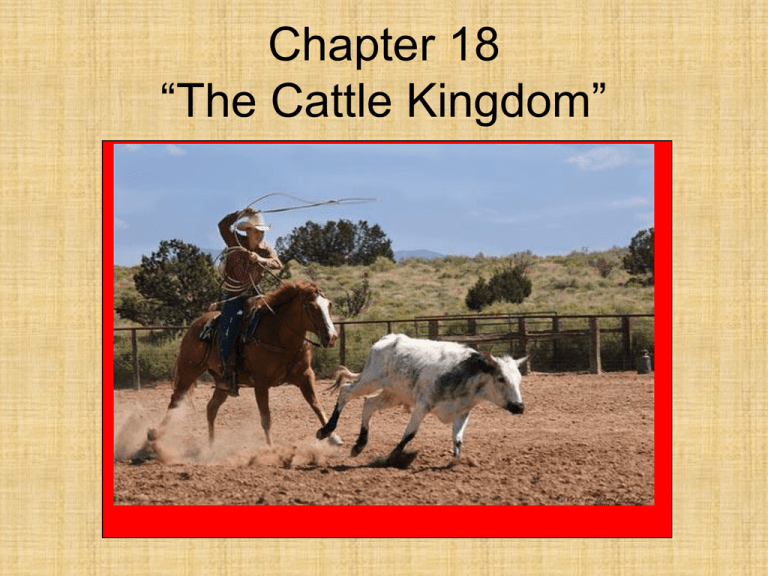
Chapter 18 “The Cattle Kingdom” *The cattle first brought to America arrived on the ships of Spanish explorers in the 1500’s. *These Spanish cattle were bred with other types, giving rise to the famous Texas Longhorn. Longhorn Calf Raising cattle began on the open range, public land that could be used by anyone. Vaqueros, or cowhands, herded and drove cattle into pens they called corrales. Cattle were branded with a hot iron to show ownership. Cattle branding is nothing new. Ancient Egyptians did it – We do too! Collage of Brands In the late 1800’s, huge ranches sprawled throughout Texas. Let’s take a look at a few of these. The King Ranch By 1925, the King Ranch was larger than some states. It had expanded to more than one million acres and 100,000 head of livestock. It was established in 1885 by Richard King. The King Ranch did, and still does, take up much of South Texas. The King Ranch It was on the King Ranch that a famous breed of cattle, the Santa Gertrudis, was developed. It was the first breed ever developed in the United States. • After the buffalo were wiped out and the Native Americans were removed from the Great Plains, West Texas and the Panhandle then became open to ranchers because there was no longer any danger from Native American raids. The JA Ranch In 1876, Charles Goodnight and John Adair established the JA Ranch in Palo Duro Canyon. Like the King Ranch, it also expanded to 1 million acres and more than 100,000 cattle. Before becoming a rancher, Charles Goodnight had been a Texas Ranger, a scout, and a military guide. Charles Goodnight’s wife, Molly, rescued and raised baby buffalo left to die by commercial hunters. The remaining buffalo had to be sold in 1998 - as they kept walking through the fences. The Shoe Bar Ranch This ranch was also located in the Panhandle, and was 450,000 acres in size. By 1913, this ranch had been broken up and sold. The owner was Thomas Bugbee. 1912 – The Shoe Bar Ranch The Matador Ranch The Matador Ranch was established in 1878 by Henry Campbell. It was, and still is, located near Lubbock in the Panhandle. The Matador - 1908 The XIT The XIT Ranch was the largest Texas ranch of the period, consisting of 3 million acres. The ranch took up 10 counties, hence the X in the name. So XIT means “Ten In Texas.” The XIT was land given to a Chicago-based company by the state of Texas. 3 million acres of land was exchanged for the agreement to build the $3 million dollar capitol building in Austin. It was also located in the Panhandle. The last of the ranch was sold in 1963. Ten counties in Texas The XIT Bob Lemmons caught mustangs (wild horses) by trailing them without changing clothes or horse until they got used to his scent. Then he would just lead them into the corral. Many large ranches, like the King Ranch, still exist in Texas today. But ranching is different from when Richard King founded the ranch back in 1853. Now, two thousand miles of fences keep the 60,000 cattle inside the ranch. In addition to horses, the ranchers use helicopters to travel around. The cattle are branded and electronic devices are attached to the ears of calves. This helps keep track of their feeding schedules and health records. After the Civil War a growing demand for wool in northeastern factories brought many sheep ranchers to Texas. Ranchers complained because the sheep ate the grass too close to the ground, leaving no grass for the cattle to eat. Farmers complained because the sheep trampled their crops. So, farmers and ranchers began to close in their ranches and farms with barbed wire fences. • Barbed wire was cheap and could be easily installed. • It pricked but did not harm the cattle. • It could not easily be blown down by the wind. The most successful inventor of barbed wire was J.F. Glidden. Because farmers and ranchers began fencing off each other’s property and then cutting down their neighbors’ fences, the Texas Legislature declared fence cutting to be a felony. Four breeds of cattle that replaced the longhorns were: Hereford Brahman Shorthorn Angus Texas Cattle Trails In the Spring, cowhands would drive the cattle in large herds to the railroad towns to the north, which were connected to stockyards by rail. In the north and east, cattle would sell for $30 to $40 a head. Charles Goodnight and Oliver Loving Days on a trail drive were long and hard. They often spent 18 hours in the saddle. The distance traveled each day was usually 10 to 12 miles. At night each cowhand took his turn at standing guard against stampedes or Indian raids. • Food for the cattle drive was kept on the chuck wagon (invented by Charles Goodnight). * The chuck wagon cook was called a “coosie,” from the Spanish word for male cook,“cocinero.” * He was at times referred to as “cookie.” The Chuck Wagon The typical cowboy was young and single – and poor. The cattle towns of Kansas were rowdy places where cowhands “let off steam” after being paid. “Here at last!”

